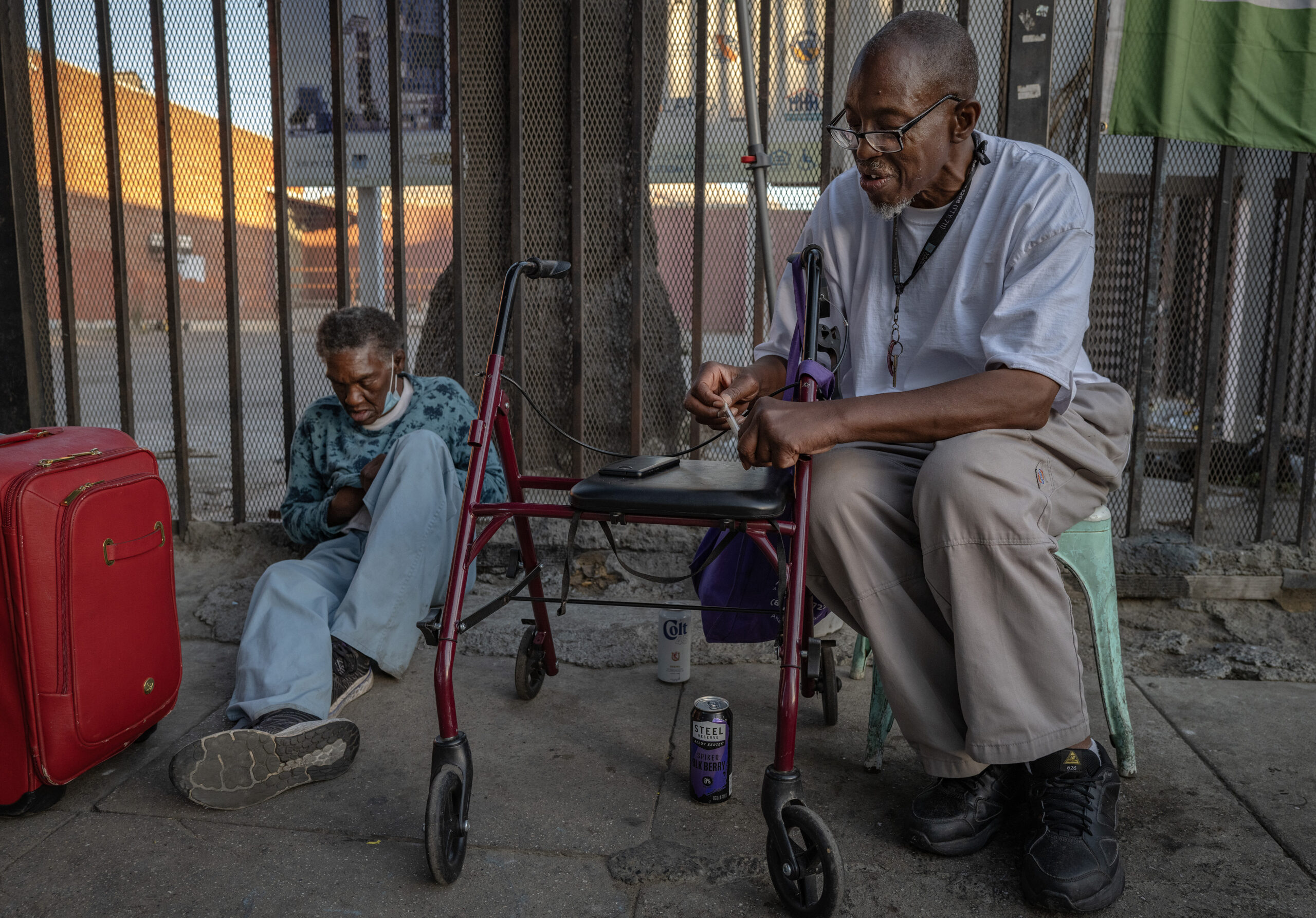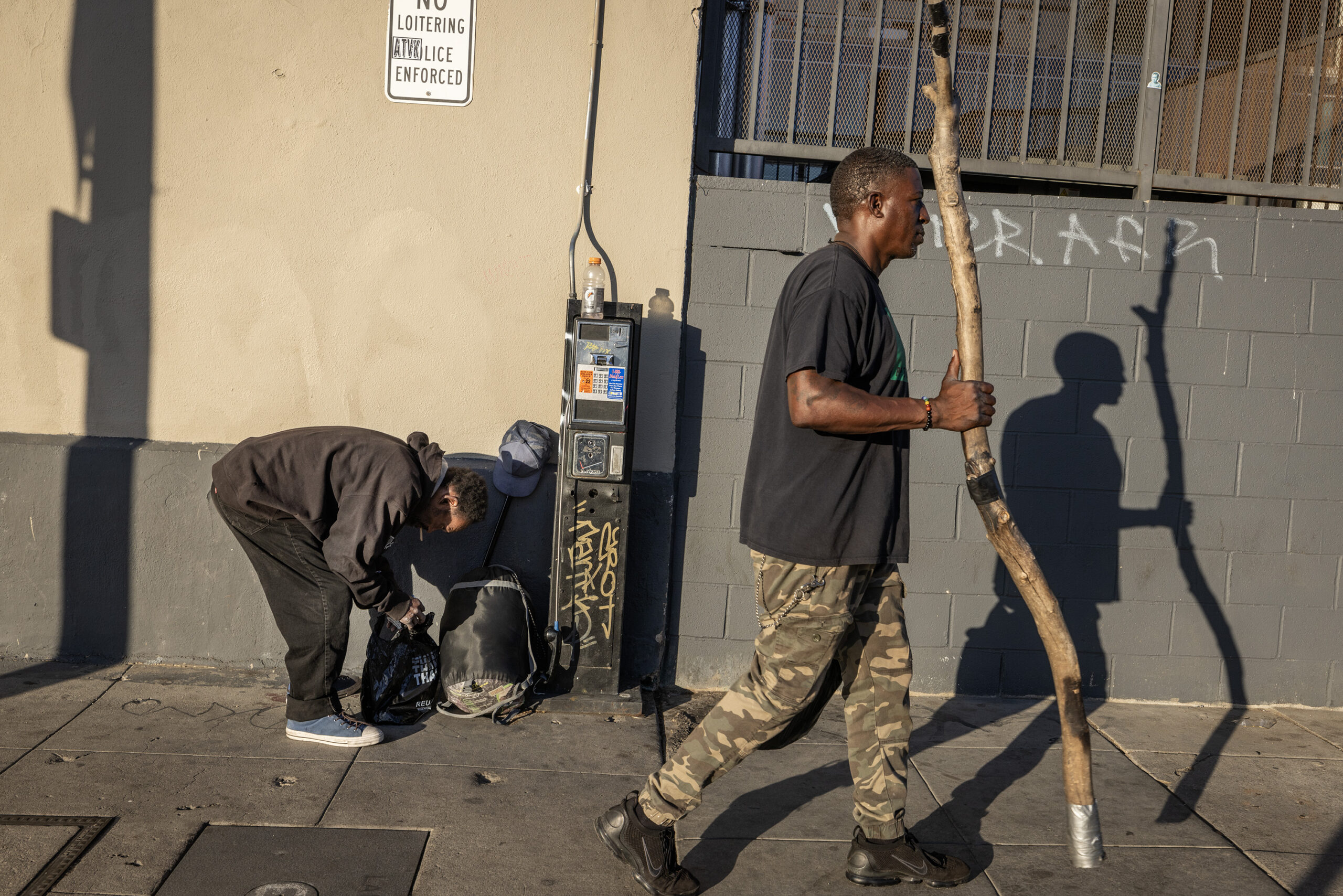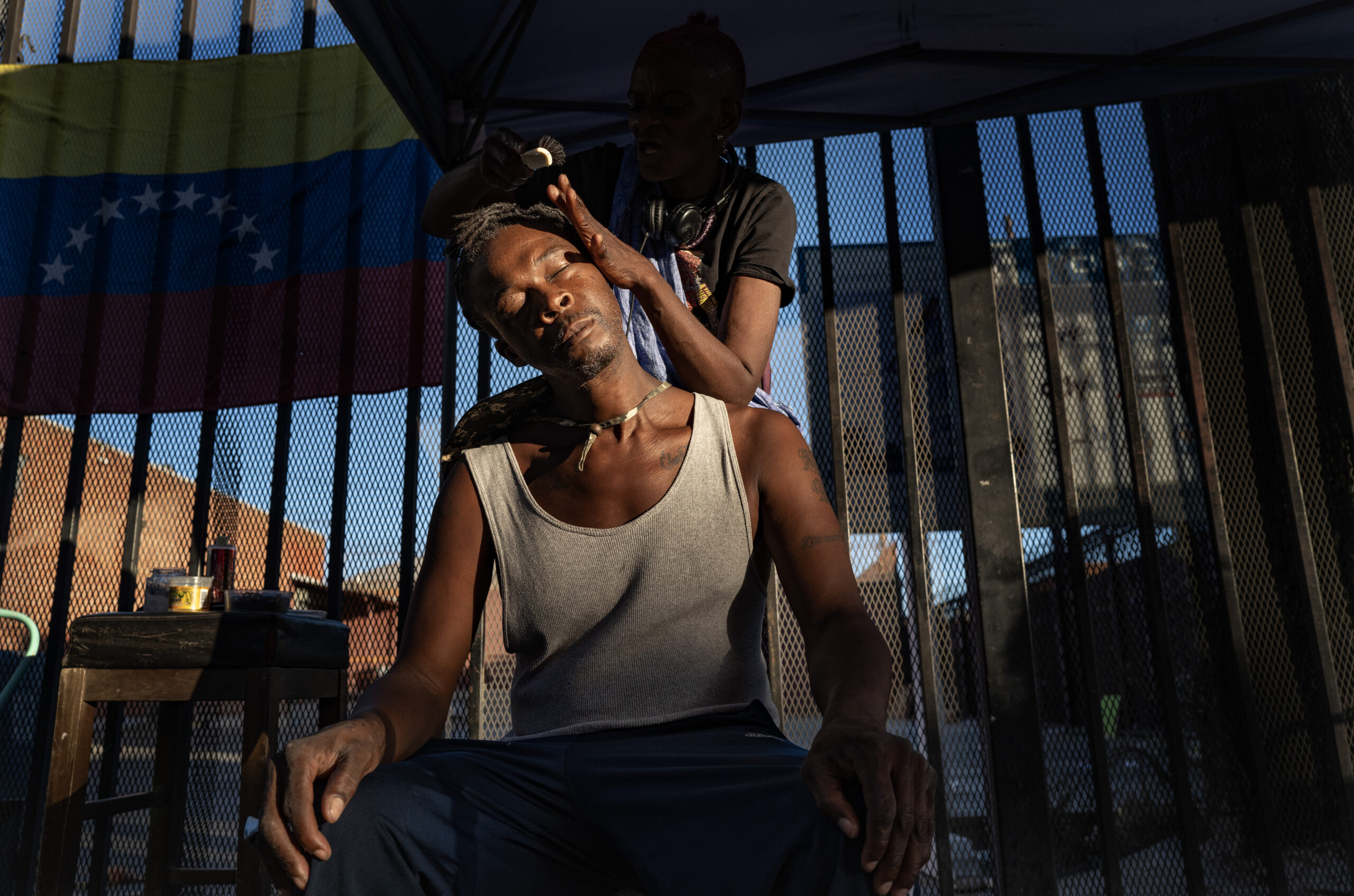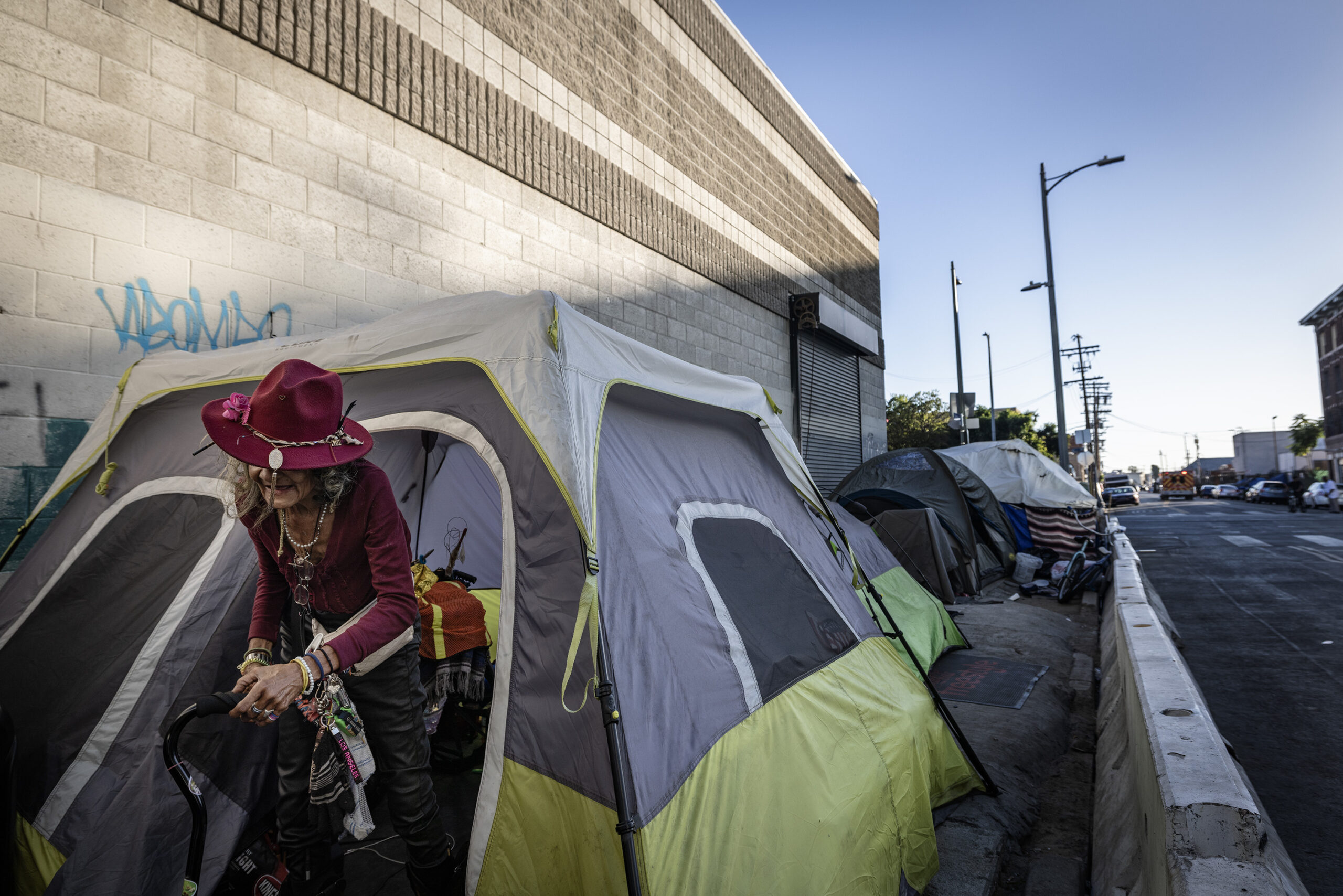Health experts say overdose prevention centers can save lives, but are illegal in most of the U.S. On Los Angeles’ Skid Row, those in need have built their own.
“Come on, kick back,” invites Quincy Brown, co-founder of the Blue Hollywood Street Sanctuary, a half-block-long stretch of sidewalk on Los Angeles’ Skid Row, where more than 4,400 unhoused people live.
Four years ago, Brown began serving barbecue here out of the back of his van. He propped up a handful of tents and canopies to shade visitors from the intense sun. Now there are folding chairs and tables where men and women play dominoes, chess and checkers, and enjoy snacks and bottled water donated by local organizations and community members who pass by.
Amid the visitors hanging out and catching up, some smoke crack cocaine, meth or marijuana, sitting on chairs in the sanctuary’s central area. The nonjudgmental environment for drug consumption is on-mission for the sanctuary. Brown, 50, was ordained as a pastor in 2005 and is known by most as Pastor Blue. He started the community space to save lives: whether through food, prayer or prevention of overdose deaths. Here, anyone can obtain free clean pipes and Naloxone (commonly known by its brand name, Narcan), a nasal spray medication with the ability to reverse overdoses. While injection drugs are less commonly used at the sanctuary, free clean needles are available.
“First and foremost, I want people to live,” says Pastor Blue. By creating a hygienic environment with lifesaving medicine at hand, he hopes to prevent overdose deaths, which over the last few years have risen sharply in Skid Row and across the country.
Pastor Blue’s sidewalk sanctuary meets a need served elsewhere by overdose prevention centers, which are common in European cities but rare in the United States. With overdose deaths rocketing upward, public health officials in Los Angeles and other U.S. cities have called for legalizing such centers, saying there’s now an abundance of evidence that they save lives. But the political will to heed that advice has not materialized.

Darren Willett, director of Skid Row’s Center for Harm Reduction, operated by the nonprofit Homeless Health Care Los Angeles, said the lack of overdose prevention centers in Los Angeles is “infuriating.” If officials approved them, “we could do it tomorrow. And yet, here we are watching people die,” said Willett.
Pastor Blue estimates there have been 20 overdoses at Blue Hollywood Street Sanctuary over the last two years — yet not one fatality.
To achieve this, monitoring is crucial. The sanctuary operates with an “I’m gonna watch over you while you use, you watch over me” approach, Pastor Blue says. “I’m constantly walking through, so if somebody sleeps too long, we’re gonna get you up.”
Illicit fentanyl has been the greatest cause of overdose. By weight, the synthetic opioid is about 50 times stronger than heroin. Even small amounts can cause respiratory difficulty, and in some cases death. Fentanyl’s potency and low production cost have led to its increasing use as an additive to other drugs.
In 2021, 2,741 people in Los Angeles County died from an accidental drug overdose, according to the Department of Public Health — more than double the number of lives lost to overdose in 2016. Fentanyl was involved in 109 deaths in 2016 and 1,504 deaths in 2021.
As fentanyl-related deaths in Skid Row began to soar, the head of the Los Angeles County Department of Public Health and other health officials called for the establishment of official consumption centers to prevent overdoses.
The L.A. County Department of Public Health released a report late last year on fentanyl overdoses that included a call for official prevention centers and other harm reduction measures, such as access to Naloxone and fentanyl test strips. At the same time, Barbara Ferrer and Gary Tsai, director of L.A. County Department of Public Health and director of Substance Abuse Prevention and Control, respectively, endorsed the centers, saying it was time for “bold action.”
“We do not tell people with diabetes that they can’t be eligible for treatment unless they comply with diet restrictions 100% of the time, or that people with heart disease can’t receive care unless they exercise,” Ferrer and Tsai wrote in a Daily News op-ed. “Overdose prevention centers … send a subtle but important message that we want to bring people who use drugs out from the corners of our communities and that they deserve unconditional and nonjudgmental services.”
Despite support from health experts and local officials, federal law bans overdose prevention centers due to the “crack house statute” — a 1986 law that prevents individuals and organizations from maintaining or opening places for the purpose of using a controlled substance. Only New York City, which has two prevention centers, has bucked that law so far, though Rhode Island, Colorado and New Mexico are taking steps to open them.
A nonprofit center operated in San Francisco for one year in 2022 as part of the mayor’s emergency plan to address the overdose crisis, though it has since closed. In recent months, other unsanctioned sites have popped up in the city to address the urgent issue of drug overdose. Like in Los Angeles, the future of prevention centers in San Francisco is uncertain.
Last summer, Sen. Scott Wiener (D-San Francisco) authored a bill to open pilot overdose prevention centers in L.A., Oakland and San Francisco. But Gov. Gavin Newsom vetoed it, saying that more planning was needed. He expressed concern the centers could open “a world of unintended consequences.”
Newsom was likely hoping to stave off “the largely GOP-driven narrative of California as a needle-infested, drug-overrun dystopia,” CalMatters stated on its website.

While Los Angeles has seen a groundswell of support for overdose prevention centers, with local leaders and community nonprofits calling for them to be legalized, none have opened.
So Blue Hollywood Street Sanctuary operates as a real-world example of the paradoxes brought about by the nation’s 52-year war on drugs. Worldwide, 16 countries have established more than 120 official overdose prevention centers where people can use drugs in a supervised environment, with staff ready to respond if they overdose. While such official centers are illegal in the U.S., Pastor Blue’s sidewalk setup serves as a one-man version of such a space.
On one summer evening, while people at Blue Hollywood were playing dominoes and hanging out, a resident who frequents the sanctuary accidentally overdosed. After smoking crack in a pipe, he began to have trouble breathing.
Pastor Blue called an ambulance, administered four doses of Narcan and performed CPR. Moments before paramedics arrived, “we revived him,” Pastor Blue said. “We had Narcan, thank god.”
Pastor Blue is fighting a problem that “does not seem to be going anywhere in the near future,” he said. “We have loved ones, we have friends, we have people that are suffering with different addictions. I’m here to meet people right where they are.”
Here on Skid Row, Blue Hollywood is an example of a community-created oasis, said Soma Snakeoil, director and co-founder of the Sidewalk Project, a harm reduction nonprofit in the neighborhood.
The sanctuary receives supplies such as clean needles, pipes and Narcan from local nonprofits like the Sidewalk Project, as well as chairs, tents, food and water from Los Angeles Mission and donors who drop by.
“For the most part, it’s a community,” says Pastor Blue, who resides near Skid Row. “I really want to preserve community, because there’s so many people who have been detached from their biological community.”
The sanctuary offers immediate support, whether it’s a tent for shelter or a freshly cooked lunch.
“By him putting this here, I think he saved a lot of people,” said Rico Solomon, a longtime sanctuary member. Born and raised in L.A.’s West Adams neighborhood, Solomon lived in a tent on Skid Row for four years before moving to an apartment in La Puente, 20 miles east of downtown. Even though it can mean three bus rides for more than an hour and a half, he returns to Blue Hollywood regularly.

Solomon says the community keeps him coming back. “It’s a bit of a commute, especially when I’m catching the bus. But I have my habits, you know. So I don’t take this stuff home with me,” he said of the drugs he consumes and the pipe he uses to smoke. “I come out here and do it. Then, when I get ready to go home, I leave it all here.”
Solomon said he’s seen four overdoses at the sanctuary and has called 911 himself to assist people experiencing an overdose, so they are able “to live to see another day.”
“People are dropping like flies around here,” said Anthony Willis, 60, who lives in an apartment in Skid Row. Born and raised in L.A., he is a father and grandfather.
Nearly a year ago, Willis accidentally overdosed. While looking to smoke crack cocaine, he borrowed a pipe. Before smoking the pipe, he asked if it contained fentanyl and was told no.
The pipe turned out to be laced with it. “I panicked,” Willis said. “I couldn’t breathe.” Emergency services arrived, though he was able to regain his breathing on his own.
Consuming drugs less frequently is one of Willis’ goals. In the meantime, treating those who consume with dignity is imperative. “We’re all human,” he said. “Don’t judge people.”
According to Willett, the Center for Harm Reduction director, a nonjudgmental approach is key.
“There’s a lot of things you can do to help people improve [their] health without stopping using drugs,” he said. Too often, he said, organizations approach the problem by focusing on abstinence. “For many people, that’s a deal breaker,” he added.
Using a harm reduction — as opposed to an abstinence — approach allows the center to engage with 95% of clients who use drugs, Willett said.
While the U.S. is now five decades deep into the war on drugs, the stigma and criminalization of drug use is a relatively new phenomenon. “In the late 1800s, you could buy cocaine and a syringe for $1.50 in the Sears catalog,” Willett said.
“There’s a direct lineage straight from slavery to Jim Crow to mass incarceration and the war on drugs,” said Willett, adding that all were tools used by the system of white supremacy to maintain control over Black people. He points out that the supposed end of Jim Crow laws in the late 1960s coincided neatly with the start of the war on drugs in 1971, which resulted in a dramatic increase in prison populations. It has cost the U.S. roughly $1 trillion to police, arrest and incarcerate people for drug-related charges, and spiked rates of overdose and death.

If you ask Willett, the war on drugs has neither met its stated goals nor alleviated the most pressing health issues: It hasn’t reduced overdose rates, soft tissue infection, infectious disease or violence related to drug trafficking. Instead, it has “devastated communities of color through reincarceration, ripping families apart for minor drug offenses and confiscating people’s homes for being associated with illicit drug trade.”
The problem isn’t drug use itself, Willett believes. It’s the way society punishes people for using drugs — targeting Black people, communities of color and low-income people in particular, despite similar rates of drug consumption and sales across racial and economic lines.
“We cannot continue doing the same thing over and over again and hoping for a different result,” L.A. City Councilmember Eunisses Hernandez said in an email, speaking to the history of criminalizing drug use and the rise in overdose deaths.
“It’s a reality that people are gonna use,” said Pastor Blue. “So on behalf of trying to keep an atmosphere where they’re at peace … safe consumption sites are very important.”
Countries with overdose prevention centers (the first opened in Switzerland in 1986) show significantly lower rates of overdose than those without. In 2020, 91,799 people died from overdose in the United States — about 58 times more than in Germany, where 1,581 people died from overdose (the U.S. population is only four times larger than Germany’s).
Jeannette Zanipatin, California director for the national advocacy group the Drug Policy Alliance, says these overdose prevention centers are not a substitute for treatment. The centers, which commonly connect clients to other services such as mental and physical health care, “keep individuals alive so that when they are ready to access treatment those linkages can be made for the individual,” Zanipatin said in an email.
In the U.S., critics from both parties have questioned their success. “Enabling those suffering from addiction to go to the brink of death is a dubious treatment,” wrote U.S. Deputy Attorney General Jeffrey Rosen, a President Trump appointee, in a 2020 opinion in the Philadelphia Inquirer.
In 2018, Gov. Jerry Brown vetoed a state measure to open a pilot prevention center in San Francisco, saying, “Fundamentally I do not believe that enabling illegal drug use in government sponsored injection centers — with no corresponding requirement that the user undergo treatment — will reduce drug addiction.” Such sentiments linger today.
In 2022, the American Medical Association called for more funding for pilot prevention centers. And recently the National Institutes of Health announced it will fund a four-year study to investigate the impact of prevention centers on both individual clients and neighborhoods — as well as estimate potential costs and savings for local medical and criminal justice systems.
NIMBYism is also an obstacle to opening prevention centers, said Zanipatin, with some fearing a center would negatively impact their community. Yet “crime rates have been reduced, syringe litter is reduced, and open drug use is reduced in places where centers are co-located in communities,” she wrote in an email.
A study of one unofficial overdose prevention center in the U.S. found that in the five years since its opening, crime decreased in the surrounding area. A review of government-sponsored prevention centers in Vancouver, Canada, found no increases in drug-related crimes or public nuisance.
As part of Homeless Health Care Los Angeles in Skid Row, a trained overdose response team of staff and clients canvasses the neighborhood in golf carts seven days a week. They are armed with a broad range of tools, including Naloxone injections, concentrated oxygen, artificial breathing masks, pulse oximeters and automated external defibrillators.
Still, one crucial service is missing: providing a safe environment for clients to consume drugs on-site.
In 2016, Homeless Health Care Los Angeles formed a partnership with The Men’s Home in Copenhagen, which operates two overdose prevention centers, and has been sending staff to Denmark to learn from these centers ever since.
Yet no such center has arrived in Los Angeles.
The Blue Hollywood Street sanctuary run by Quincy Brown (“Pastor Blue”) demonstrates the paradox brought about by the nation’s now 52-year war on drugs. Worldwide, 16 countries have established more than 120 official overdose prevention centers where people can use drugs in a supervised environment, with staff ready to respond if they overdose. While such centers are illegal in the U.S., Pastor Blue’s sidewalk set-up serves as a one-man version of such a space. “First and foremost, I want people to live,” says Pastor Blue. By creating a hygienic environment with life-saving medicine at hand, he hopes to reverse the upswing in overdose deaths, which over the last few years have risen sharply in Skid Row and across the country.
All photos taken by Barbara Davidson on October 24 for Capital & Main.















Copyright 2023 Capital & Main